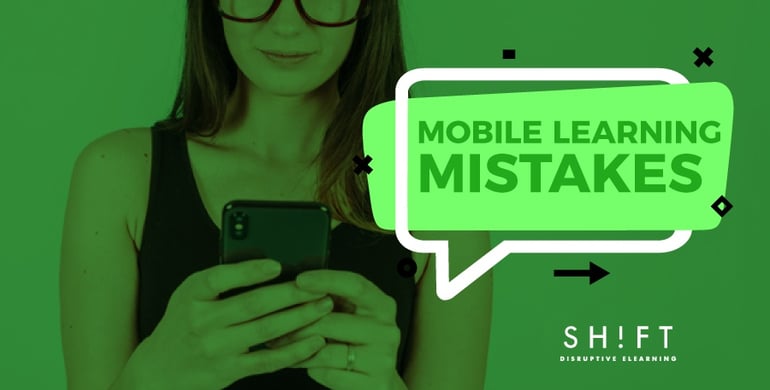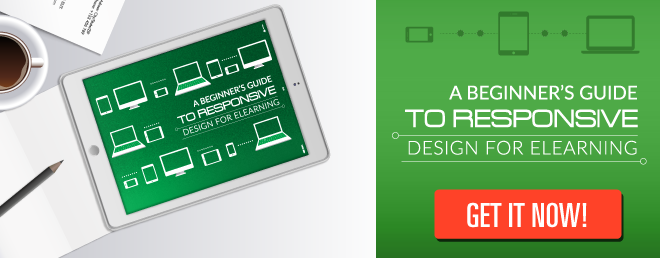Mobile learning is a big deal! Every business is now focusing on mobile learning as a strategy to engage and train a remote and globally distributed workforce.
However, as exciting as it may be, the decision to start implementing mobile learning takes time, effort, and adopting a new mindset. Embracing a mobile mindset means more than simply using mobile devices to train employees. It also means understanding the mobile behavior of your target audience and acting accordingly.
The decision to move face-to-face training or desktop-only eLearning courses from a computer monitor to a small personal screen does require repurposing efforts too. Mobile learning can be extremely effective, but it's not a given. This "on-the-go training dynamic" is only useful when it’s done correctly.
Below is a list of four basic mistakes to avoid while designing your mobile learning course.

Mistake #1) Prioritizing the "Shiny & New" Over the "Simple & Effective"
When it comes to mobile learning, many designers fail because they focus on how they will be delivering information instead of how the user’s device will receive it. If you fail to consider the context of the user’s device, little can be done to salvage your efforts.
At the end, when it comes to mobile user experiences, the user experience matters A LOT and can quickly get in the way of real learning to happen.
New and seasoned designers alike are over-eager to feature the “shiny, new” technologies that their employees are using. They forget the golden rule of instructional design: Keeping it simple! How do you do that? Glad you asked, stick to the basics:
- Think devices: Mobile design will need to be based on physical properties. Because devices vary, if your budget is limited, it’ll be important to design for the smallest screen. But above all: make sure you use a responsive authoring tool, like SHIFT :)
- Only "Must-know" Content: The small screen of a smartphone allows you to focus on what is truly important. Too much text is boring and tough on the eyes. Too many images are heavy and tough on the phone.
- Size matters: Separate from the aesthetic of the design, you’ll want to make sure that the media you include aren’t too heavy. The on-the-go culture will have little patience for media-heavy screens. Devices vary in capabilities, and it’s not a risk worth taking to include large videos or graphics.
Also read: 5 Essential Mobile Learning Design Rules You Should Be Following
Mistake #2: Skipping Strategy
All too often, someone will decide to create mobile learning without considering exactly WHY and HOW it's going to be implemented, which means it never really gets off the ground.
Don't pour resources into mobile learning without a cohesive strategy. First, define your business need in detail and how mobile will help address this need. Then create a structured plan. Skipping this can lead to a lack of purpose in content and loss of trust from the student.
In simple terms, a good mlearning strategy should clearly define its target audience, its learning content, and technologic architecture.
Start addressing some questions such as:
- What do I want to accomplish with a Mobile Learning Program
? - What type of content is best suited for mobile?
- How will you track mobile learning use?
- What will you use to measure success?
- How will the program be sustained? Successful mobile learning programs should have established processes that can be replicated and scaled later on.
Having considered these basic questions will keep your course focused and your audience confident of their investment of time and energy in your program.
Also read: First Steps to Implementing a Mobile Learning Program
Mistake #3: Classic Copy-Pasting
We have all started reading an email only to realize that it’s a mass email. Feeling jipped, we think “Oh, it’s not for me.” It’s not a nice feeling. Let’s avoid it altogether.
Let’s just state the obvious--copy and paste your existing eLearning content to your mobile course doesn’t cut it. Elearning programs are designed to be viewed on the computer screen. The fixed screen dynamic is different. Your students are on a small screen now. Text, resolutions, and features were all a carefully decided part of their experience. Tiny details won’t register and device capabilities will vary.
Your content has to be repurposed. You’ll want to make it a simple, direct, and informative experience from the get-go. Your mobile courses require smaller chunks of information and some consideration for smaller screen size
Note: Mobile courses should run about half the time of your average 30-minute eLearning course.
Also read: Understanding The Difference Between eLearning and mLearning
Mistake #4: Completely Disregarding Your Audience
Learners will be jumping on and off your site at their convenience. There will be distractions. They may be at the airport; they may be at the doctor’s office. They may not be able to use video or hear an audio lesson. Keep these things in mind. Creating unexpected hurdles in a lesson will hurt you in the long run.
If you do decide to include links to audios, make it a point from the beginning. That way your student isn’t caught off guard, unable to advance. If your content is relevant, the last thing you will want is to lose a student’s attention because of a design issue.
Many of the sections of a mobile strategy will fall into place as you go. However, establishing the audience early on can set a clearer path early on. These questions may help you get started:
- Do you have employees who work remotely? If so, what kind of training would properly address field service techs or repair techs?
- Do you have employees that travel often? Would they benefit from being able to access training material while on an airplane or someplace remote with spotty cell access?
- What type of devices will your learners use? When will they access it and how often?
Be harsh when answering these questions about your audience. The last thing you’ll want is to spend time and money developing functionality on a mobile course that your target learner won’t use.
Read: These 27 Questions Will Help You (Really) Know Your Learners
Mobile learning courses allow students or employees to catch up quickly, anytime, anywhere. Help them achieve that. Make it simple, make it clean. Make sure that everything that you’ve included is a must and nothing creates a sense of doubt. Once you’ve got these basics down, you can begin to focus on some of the "funner" features of your new course platform, for example, taking advantage of the social collaboration aspect that mobile can offer!
What are some of the worst mobile learning mistakes that you’ve made? Please share some of your stories with us in the Comments section below! Please share this post if you found it helpful.


